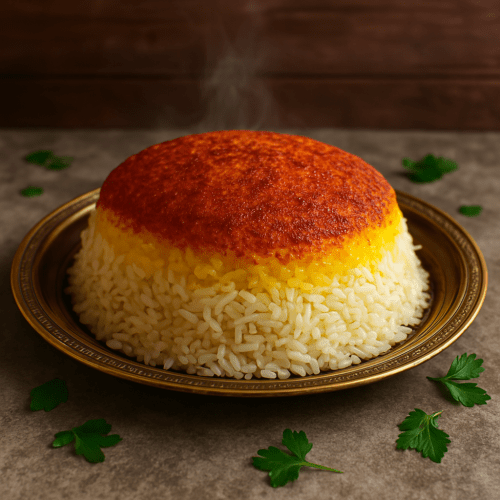Ask Cookix, your sous-chef
Persian Saffron Rice with Tahdig Crust
Persian Saffron Rice with Tahdig, or Polo ba Zaferoon, is a cornerstone of Persian culinary tradition—revered for its ethereal aroma and crisp, golden crust. The dish exemplifies Iran’s masterful approach to rice cookery, where each grain is gently coaxed to fluffy tenderness through careful parboiling and steaming. The prized Tahdig—an amber-hued layer of rice infused with fragrant saffron—forms at the bottom of the pot, delivering a textural counterpoint to the tender grains above. Often served alongside khoresh (Persian stews) or grilled meats, this rice is a celebration staple and the hallmark of a seasoned cook. Executing a proper Tahdig demands patience and precision, but the reward is a dramatic, golden crown that delights both eye and palate. Perfect for festive gatherings or as a show-stopping side, this rice transforms humble grains into edible art.
Time to complete
Prep
1h
Cook
1h
Wait
0 minutes
Total
2h
Ingredients (Serves 4 to 6)
Ingredients
- 2 cups (400 g) white basmati rice, soaked for 1 to 6 hours and thoroughly rinsed
- 8 cups (1.9 L) water, for boiling
- 2 tablespoons (30 g) salt
- 1/4 teaspoon (0.5 g) saffron threads, ground
- 2 tablespoons (30 ml) hot water, for steeping saffron
- 1/4 cup (60 ml) additional water, for steaming
Neutral Oil
- 3 tablespoons (45 ml) neutral oil, for forming Tahdig
- 2 tablespoons (30 ml) neutral oil, for drizzling
Nutrition Information (per 100g)
- Calories: 165
- Fat: 5
- Protein: 3
- Carbohydrates: 28
- Fiber: 0.7
Directions
Preparing the Rice
- 1. Thoroughly rinse the basmati rice in several changes of cold water until the water runs clear. Soak the rice in cold water for at least 1 hour and up to 6 hours. Drain before using.
Parboiling the Rice
- 2. In a large, covered pot, bring 8 cups (1.9 L) of water to a rolling boil. Add the salt and drained rice. Boil uncovered over high heat for 5–7 minutes until the grains are tender on the outside but firm within (al dente). Drain immediately and set aside.
Creating the Tahdig
- 3. Grind the saffron threads to a fine powder and mix with 2 tablespoons (30 ml) hot water. Let steep for 5 minutes. In a small bowl, combine about 1 cup (200 g) of the parboiled rice with the saffron water. Heat 3 tablespoons (45 ml) neutral oil in a nonstick or heavy-bottomed 25–28 cm (10–11 inch) pot over medium heat. Spread the saffron-infused rice over the bottom in an even, compact layer to form the Tahdig crust.
Steaming the Rice
- 4. Gently mound the remaining rice over the Tahdig, shaping it into a dome. Drizzle the remaining 2 tablespoons (30 ml) of oil evenly on top. Pour 1/4 cup (60 ml) water over the rice. Wrap the pot lid with a clean kitchen towel to absorb moisture, cover tightly, and reduce the heat to medium-low. Steam for 45 minutes without disturbing.
Serving
- 5. When ready, remove the lid. To unmold, gently run a spatula around the edges to loosen. Place a large serving platter over the pot and carefully invert. The Tahdig should release as a golden crust atop the fluffy rice. Serve immediately.
Cookix's Secrets
Alternative Tahdig Layers
- Use lavash bread, thin potato slices, or yogurt-mixed rice as alternative Tahdig bases for varied textures and flavors.
Crispy Tahdig
- Use a non-stick or heavy enameled pot to increase the chance of releasing an intact Tahdig.
Flavor Enhancements
- Add slivered almonds or barberries (zereshk) to the rice for added texture and tartness.
Healthier Option
- Reduce oil slightly and use olive oil for a heart-healthy version, keeping in mind this may alter the crispiness of the Tahdig.
Protein Pairings
- Serve alongside Persian stews (like Ghormeh Sabzi or Fesenjan), grilled kebabs, or roasted vegetables for a complete meal.
Rinsing & Soaking
- Rinse the rice thoroughly to remove surface starch, which helps achieve fluffy, separate grains. Soaking improves texture and reduces cooking time.
Saffron Infusion
- For maximum aroma, grind saffron with a pinch of sugar before steeping it in hot (not boiling) water.
